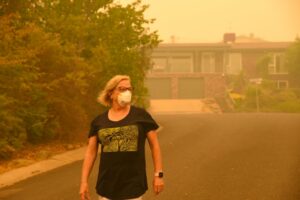After a summer that included a surprise tropical storm, we’re now moving into the prime period for wildfire danger in Southern California. For most local homeowners, wildfires are the most terrifying threats possible. Many have already had the experience of fires getting too close to their homes—or had their homes destroyed.
One piece of good news for this season: the massive August rainfall will help push back the wildfire threat. That doesn’t mean you can just assume you won’t have to deal with the danger of fires, however.
Fire damage restoration in Orange County, CA is an important part of what we do at Jarvis Restoration. In this post, we’ll share important information about the wildfire season, how to protect your home, and how to prepare for an emergency.
The Basics of Wildfire Season
Wildfire season in Southern California typically occurs during the late summer and fall, although fires can strike year-round, and some climatologists now believe the wildfire season no longer exists—because it’s always wildfire season.
The reason for the high danger is a combination of dry conditions that make the landscape a pile of dry kindling ready to ignite, the dry and strong Santa Ana winds that make fire control difficult, and the arid nature of our local vegetation.
Protecting Your Home
- Defensible Space: Clear dead vegetation, leaves, and debris from around your home and trim trees and shrubs. This creates a space to defend the house from a fire easily leaping to it.
- Fire-Resistant Landscaping: Choose fire-resistant plants and materials for your landscaping.
- Roof and Gutters: Clean the roof and gutters of leaves and branches that will easily ignite.
- Fire-Resistant Building Materials: If you renovate your home, consider using the best in new fire-resistant materials.
- Wildfire-Resistant Windows: Here’s an easier upgrade to make if you don’t plan a larger remodeling—put in wildfire resistant windows.
Emergency Preparedness
Along with getting your house ready, you and your family need to be ready with an emergency plan.
- Evacuation Plan: Create a detailed evacuation plan with multiple escape routes. Make sure all family members are familiar with it.
- Emergency Kit: Prepare an emergency kit with essential supplies—food, water, medications, important documents, etc.
- Communication: Establish a communication plan with family members. Designate an out-of-area rendezvous point in case people get separated.
- Alert Systems: Stay informed about wildfire updates through local news, alerts, and apps.
- Insurance: Review your homeowner’s insurance policy to make sure it covers wildfire damage.
During a Wildfire
If a wildfire is approaching your area:
- Stay Informed: Monitor local news. Follow evacuation orders promptly.
- Evacuate Early: Don’t wait until the last minute to evacuate. Fires can swiftly change direction and you may encounter blocked roads.
- Protect Your Home: If you have the time, shut off gas and electricity, close windows and doors, and turn on sprinklers to wet the outside of your home.
Above all, remember, “Safety First.” Protecting the lives of you and your family comes before protecting your home and property. Leave that job to the professionals and focus on keeping safe.
Recovery and Restoration
If your home sustains damage during a wildfire, contact us afterwards, even before calling your insurance provider. We have extensive experience dealing with fire damage. We’ll assess the damage and use the information to work with your insurance company. We’ll see your home is restored to its original condition. That’s why we’re here.
For comprehensive home restoration services you can rely on, contact Jarvis Restoration today!

